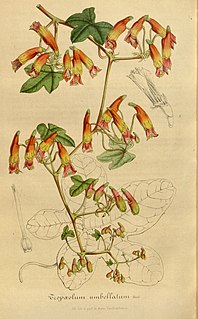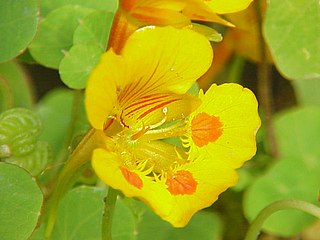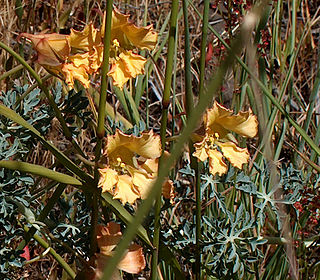
Tropaeolum, commonly known as nasturtium, is a genus of roughly 80 species of annual and perennial herbaceous flowering plants. It was named by Carl Linnaeus in his book Species Plantarum, and is the only genus in the family Tropaeolaceae. The nasturtiums received their common name because they produce an oil similar to that of watercress.

Tropaeolum tuberosum is a species of flowering plant in the family Tropaeolaceae, grown in the Andes, particularly in Peru and Bolivia, and to a lesser extent in Ecuador as well as in some areas of Colombia, for its edible tubers, which are eaten cooked or roasted as a vegetable. It is a minor food source, especially to native Amerindian populations. Mashua is a herbaceous perennial climber growing to 2–4 m (7–13 ft) in height. It is related to garden nasturtiums, and is occasionally cultivated as an ornamental for its brightly coloured tubular flowers.

Tropaeolum majus, the garden nasturtium, nasturtium, Indian cress or monks cress, is a species of flowering plant in the family Tropaeolaceae, originating in the Andes from Bolivia north to Colombia. An easily-grown annual or short-lived perennial with disc-shaped leaves and brilliant orange or red flowers, it is of cultivated, probably hybrid origin. It is not closely related to the genus Nasturtium.
Pristimantis leoni is an endangered species of frog in the family Craugastoridae. It is found in Colombia and Ecuador. Its natural habitats are tropical moist montane forests, high-altitude shrubland, high-altitude grassland, rural gardens, and heavily degraded former forest.

The Canary Islands large white is a species of butterfly in the family Pieridae. It is endemic to the Canary Islands (Spain).
Rhipsalis pacheco-leonis is a species of plant in the family Cactaceae. It is endemic to Brazil. Its natural habitats are subtropical or tropical moist lowland forests and rocky areas. It is threatened by habitat loss. It needs water and sunlight.
Tropaeolum asplundii is a species of plant in the Tropaeolaceae family. It is endemic to Ecuador. Its natural habitat is subtropical or tropical moist montane forests.
Tropaeolum brideanum is a species of plant in the Tropaeolaceae family. It is endemic to Ecuador. Its natural habitat is subtropical or tropical moist montane forests.
Tropaeolum carchense is a species of plant in the Tropaeolaceae family. It is endemic to Ecuador. Its natural habitat is subtropical or tropical high-altitude grassland.
Tropaeolum huigrense is a species of plant in the Tropaeolaceae family. It is endemic to Ecuador. Its natural habitat is subtropical or tropical moist montane forests.
Tropaeolum magnificum is a species of plant in the Tropaeolaceae family. It is endemic to Ecuador. Its natural habitats are subtropical or tropical moist montane forests and subtropical or tropical high-altitude grassland.
Tropaeolum menispermifolium is a species of plant in the Tropaeolaceae family. It is endemic to Ecuador. Its natural habitat is subtropical or tropical high-altitude grassland.
Tropaeolum papillosum is a species of plant in the Tropaeolaceae family. It is endemic to Ecuador. Its natural habitat is subtropical or tropical moist montane forests.

Tropaeolum umbellatum is a species of plant in the Tropaeolaceae family. It is endemic to Ecuador. Its natural habitat is subtropical or tropical moist montane forests.
Cryptocentrus leonis is a species of goby native to marine and brackish waters along the shores of the Gulf of Thailand.

Tropaeolum minus, the dwarf nasturtium is a species of perennial plant in the Tropaeolaceae family. It is endemic to mountainous regions of Ecuador and Peru.

Tropaeolum incisum is a species of nasturtium, with flaring petals in shades of yellow and peach, when still in bud and on the outside darker, more orange-brown and sometimes stained purple, with creeping or climbing stems, in the wild up to about 60 cm long with deeply divided, blue-grey leaves, with undulating lobes, that grows on the dry eastern side of the southern Andes mountains.
Phyllodactylus leoni is a species of gecko. It is endemic to Ecuador.

Tropaeolum hookerianum is a species of perennial plant in the Tropaeolaceae family. It is found in Chile.

Symphyotrichum leone is a species of flowering plant in the family Asteraceae native to Cuba. It is also spelled Symphyotrichum leonis.









